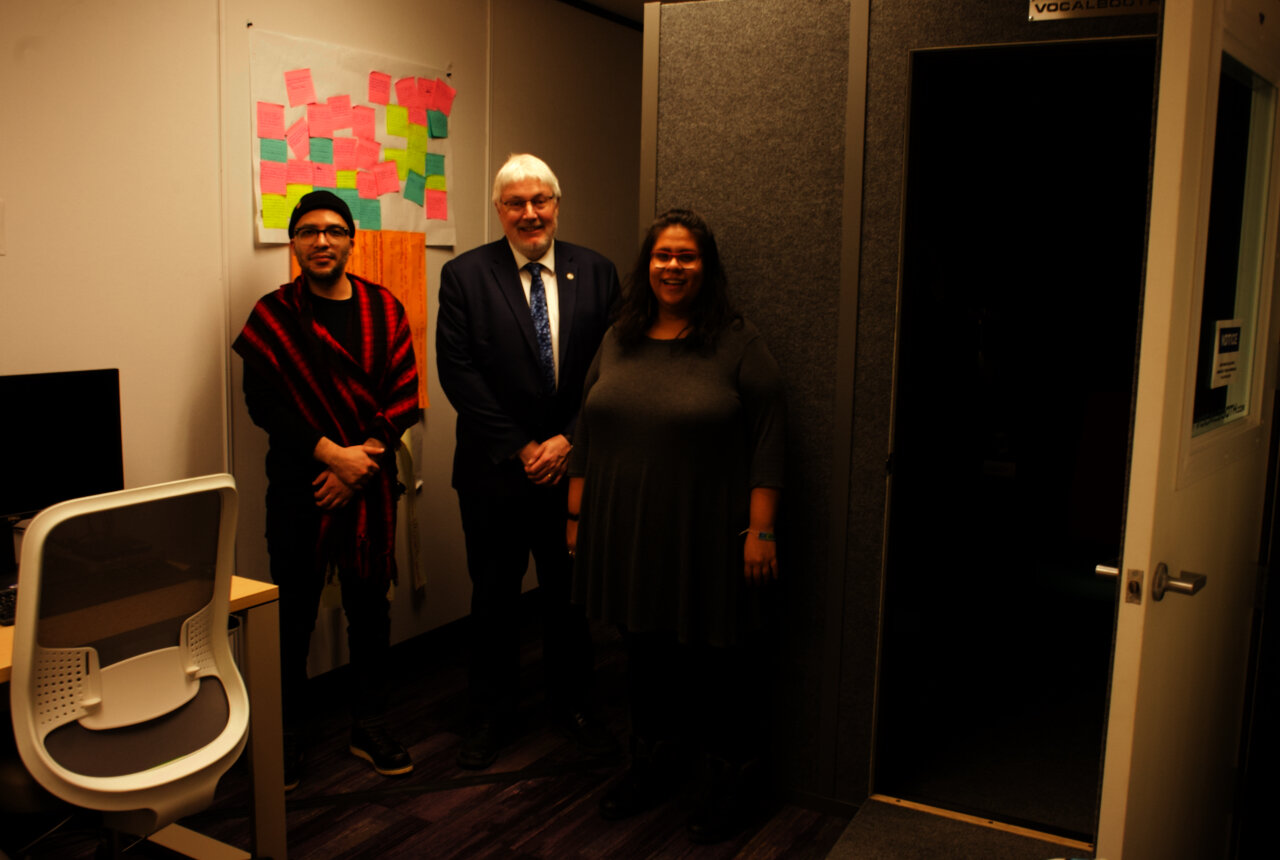Our lab space
Image of one of the interior windows in our lab space. There is a large transparent overlay of braided sweetgrass on the windows
Tkaronto CIRCLE Lab Space
The Tkaronto Circle Lab space is a collection of rooms located at OISE. The Lab provides space and tools for the facilitation of research activities, collaboration, and community gathering. It was established in 2017 through a Canada Fund for Innovation (CFI) grant awarded to Eve Tuck for the purpose of creating a meaningful and collaborative working environment, particularly for Black and Indigenous students, faculty, and community researchers. Each room in the space has a particular function and has been intentionally designed with Indigenous ethics of community, reciprocal knowledge sharing, and accessibility at the forefront.
AIR Space
AIR Space
The Archive on Indigenous Research/Resistance (AIR) Space is a central gathering place for the department of Social Justice Education and guests. It is meant to be a welcoming space for community members, students, faculty and staff of OISE to meet and share ideas. The space features a beautiful round meeting table which exemplifies the collaborative spirit of the CIRCLE Lab. The cabinets in this space will house the physical materials that will be part of a largely digital archive on collaborations in Indigenous research and social movements. The AIR Space doubles as a meeting space and collaborative research hub. In-room technology for high-quality audio and video communications and recording will make this room a studio in which research activities, meetings, and presentations can be recorded and broadcasted. For example, interviews or talks might be held in the AIR Space, and recorded or live streamed for research or circulation purposes. In addition to meetings and special gatherings, it is anticipated that many knowledge mobilization activities will also be held in this space, including research workshops, small conferences, and recorded research demonstrations. This room is available to anyone affiliated with the department for booking.
Space Activities:
-Research data collection, storage, analysis, and sharing
-Virtual and in-person meetings
-Celebrations and ceremonies
The Intergenerational Knowledge Room
The Intergenerational Knowledge Room
The Intergenerational Knowledge room functions as the hub for community researchers and community-based research. For generations, Indigenous and Black community members have been excluded from meaningful schooling and the university. Alongside youth researchers, this space is meant to welcome community researchers, and researchers who are Elders into a culturally safe university environment for the purpose of meaningful knowledge sharing. This room will also include a medicine library. This space is also used for community meetings by several groups in Toronto, as well as a space where students can engage in research activities with community members.
Space Activities:
-Research data collection activities
-Virtual and in-person meetings
-Student and community research collaborative workspace
-Data analysis workstations
-Writing space alongside plants and medicines
-Small group teachings
Meaningful Materials Room
Meaningful Materials Room (usually way more messy!)
The Meaningful Materials Room is a space for arts-based research dedicated to working with youth researchers, and designing, conducting and analysing youth participatory action research. It has been designed so that university-based researchers and youth researchers can use art materials alongside digital technologies to create research. Products of the research will include zines, beading, blanket making, web design, screen printing, graphic novels and other types of products. One of the inspirations of this room is a studio space that the late Queer Studies theorist Eve Kosofsky Sedgwick provided for her students in the early 2000s. This space is meant to be vibrant, generous, and generative. This space is also sometimes used for lab meetings and courses where access to arts-based materials are beneficial to discussion.
Space Activities:
-Research design and facilitation
-Student and youth researcher collaborative workspace
-Arts-based and technology-based participatory research activities
-Virtual and in-person meetings
The CAVI
Pedro Moran-Bonilla, Glen Jones, and Marleen Villanueva in the CAVI
The Collaborative Audio-Visual Inaanagidoonewigamig (CAVI) is a room dedicated to supporting visual and audio-based Collaborative Indigenous Research. It is accessed through the Meaningful Materials Room. “Inaanagidoonewigamig” is an Anishinabemowin word-phrase that refers to “a place one goes to think and speak in a certain way”. This room is designed to facilitate the development of media artifacts. Visual and audio-based research methods are best implemented with the use of dedicated workstations to create, store, analyze, and share data. This two-station production suite is used for development and post-production of research objects in various media formats, including podcasts, web design, video game creation, and visual and recording-based research. The CAVI includes a customized Vocal Booth, a sound-isolating booth that is equipped with professional audio gear for podcast and interview recording
Space Activities:
-Podcast recording in Vocal Booth
-Visual and recording-based research
-Visual and audio editing
-Visual and audio data analysis
The Student Workspace
The student workspace was completed in November 2019. This space is for students in Dr. Tuck’s co-mentoring group and members of the Tkaronto CIRCLE Lab. In this space, students gather, meet and collaborate on tasks and assignments in the Lab in addition to any other work they may be engaged in. This space has been generative in many ways as it serves multiple purposes of supporting the Lab and supporting students in their own work. There are lockers and workstations that include standing/adjustable desks, typical desks and cafe seating. This working space may alternate between being quiet and busy as students may be working on their own projects, or meeting in the space for lab tasks and other assignments.
Space Activities:
-Work on lab tasks and assignments
-Students working on their own projects
-Virtual and in-person meetings






